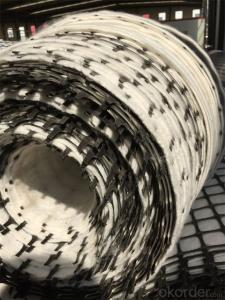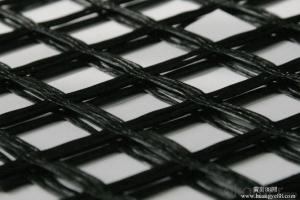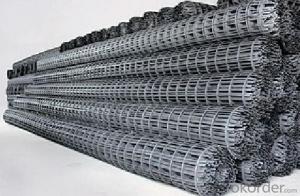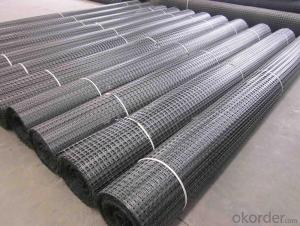Geogrids Nptel Plastic Biaxial Geogrid for Road Construction
- Loading Port:
- China main port
- Payment Terms:
- TT OR LC
- Min Order Qty:
- 20000 m²
- Supply Capability:
- 2000000 m²/month
OKorder Service Pledge
Quality Product, Order Online Tracking, Timely Delivery
OKorder Financial Service
Credit Rating, Credit Services, Credit Purchasing
You Might Also Like
1. Description
Plastic biaxial geogrid with high strength steel wire (or other fiber), through special processing, and polyethylene (PE) or polypropylene (PP), and adding other assistants, by extrusion into composite type high tensile belt, and the surface is rough textured, for high strength reinforced geotextile strips. The single band, the longitudinal, transverse certain space preparation or clamping arrangement, with special reinforcement welding technology welding the connection point bonding and molding, is reinforced with Geogrid.
Make reinforce treatment for various kinds of soft soil foundation to evenly distribute load stress and reduce uneven settlement, not easy to generate static electricity, and flammability property good in the coal mine. It is easy to wash coal.
Used in highway, railway, port, airport and municipal project. Support in the recovery working face of coal mine and roadway in the coal mine.
3. Properties
High stength,small deformation, homogenous stucture, easy for constrution etc.
FAQ:
Q:How about the delivery time?
A:Lead time since receipt of 30% T/T deposit payment: 3 weeks.
Q:What kind of payments does jenor support?
A:T/T, L/C, Cash are accepted.
Q:What's are the MOQ?
A:We can according to your condition to set the MOQ.
And we can provide you samples for quality inspection.
Q:Do you charge for the samples?
A:Accordeing to our company policy, the samples are freee, we only charge the freight fee. And we will return the freight fee If you set the order .
Q:Can you produce the product according to customers' requirements ?
A:Sure, we are professional manufacturer, OEM and ODM are both welcome.
Plastic biaxial geogrid with high strength steel wire (or other fiber), through special processing, and polyethylene (PE) or polypropylene (PP), and adding other assistants, by extrusion into composite type high tensile belt, and the surface is rough textured, for high strength reinforced geotextile strips. The single band, the longitudinal, transverse certain space preparation or clamping arrangement, with special reinforcement welding technology welding the connection point bonding and molding, is reinforced with Geogrid.

Make reinforce treatment for various kinds of soft soil foundation to evenly distribute load stress and reduce uneven settlement, not easy to generate static electricity, and flammability property good in the coal mine. It is easy to wash coal.
Used in highway, railway, port, airport and municipal project. Support in the recovery working face of coal mine and roadway in the coal mine.
3. Properties
High stength,small deformation, homogenous stucture, easy for constrution etc.
4. Specification

FAQ:
Q:How about the delivery time?
A:Lead time since receipt of 30% T/T deposit payment: 3 weeks.
Q:What kind of payments does jenor support?
A:T/T, L/C, Cash are accepted.
Q:What's are the MOQ?
A:We can according to your condition to set the MOQ.
And we can provide you samples for quality inspection.
Q:Do you charge for the samples?
A:Accordeing to our company policy, the samples are freee, we only charge the freight fee. And we will return the freight fee If you set the order .
Q:Can you produce the product according to customers' requirements ?
A:Sure, we are professional manufacturer, OEM and ODM are both welcome.
- Q: What is the effect of installation damage on geogrid performance in long-term applications?
- Installation damage can have a significant impact on the performance of geogrids in long-term applications. Damage during installation, such as improper handling, stretching, or tearing, can reduce the structural integrity of the geogrid. This can result in decreased load-bearing capacity, reduced soil confinement, and potential failure of the geogrid system over time. It is crucial to ensure proper installation techniques and quality control measures to minimize installation damage and maintain optimal geogrid performance in long-term applications.
- Q: Are geogrids suitable for use in green roof systems?
- Yes, geogrids are suitable for use in green roof systems. They provide structural support and reinforcement for the soil and vegetation layers, helping to prevent soil erosion and improve the overall stability and longevity of the green roof system. Geogrids also aid in distributing the load and reducing stress on the roof structure.
- Q: What are the design considerations for geogrid-reinforced structures?
- Some design considerations for geogrid-reinforced structures include the type and strength of the geogrid material, the soil characteristics and conditions, the required structural integrity and stability, the anticipated loads and stresses, the desired lifespan of the structure, and the overall cost-effectiveness of the design. Additionally, factors such as installation and construction techniques, environmental impacts, and local regulations may also need to be taken into account during the design process.
- Q: How do geogrids help in reducing the risk of soil erosion?
- Geogrids help in reducing the risk of soil erosion by providing reinforcement to the soil, increasing its stability and resistance to erosion. They are typically made of strong materials, such as plastic or polymer, and are installed beneath the topsoil or within the soil layers. Geogrids act as a barrier, distributing the load and reducing the pressure on the soil. This prevents soil particles from being washed away by water or wind, thus minimizing erosion and preserving the integrity of the landscape.
- Q: Is there a big difference between horizontal permeability and vertical permeability coefficient
- For example, geotextile, geomembrane, soft water pipes, etc.. According to the direction of the water flow, the coefficient of permeability of the geotextile is measured
- Q: How do geogrids enhance soil reinforcement?
- Geogrids enhance soil reinforcement by providing additional tensile strength to the soil, effectively distributing and transferring the applied loads. They create a stable and reinforced soil structure by interlocking with the soil particles and confining them in place, preventing lateral movement and improving overall stability. This reinforcement helps to minimize soil erosion, increase load-bearing capacity, and extend the lifespan of the structure.
- Q: What are the advantages of using geogrids in ground improvement for liquefaction mitigation?
- Geogrids offer several advantages when used in ground improvement for liquefaction mitigation. Firstly, geogrids provide increased shear strength to the soil, which helps to prevent liquefaction during seismic events. They enhance the stability and load-bearing capacity of the ground by effectively distributing loads and reducing settlements. Additionally, geogrids improve the overall performance of the soil by increasing its stiffness and reducing its compressibility. This ultimately leads to a more stable and resilient ground, reducing the risk of liquefaction-induced damage. Furthermore, geogrids are lightweight, easy to install, and cost-effective, making them a practical choice for ground improvement projects.
- Q: Do geogrids provide reinforcement to geosynthetic clay liners in waste containment facilities?
- Yes, geogrids can provide reinforcement to geosynthetic clay liners in waste containment facilities. Geogrids are commonly used in conjunction with geosynthetic clay liners to enhance their tensile strength and prevent their displacement. This reinforcement helps to improve the overall stability and performance of waste containment facilities.
- Q: Where can I do three to the geogrid test?
- There's a lot more to do. The key is where you are. See if there is a recent. The test of top breaking, puncture and tear of geotextiles.
- Q: Can geogrids be used in bridge abutments and approach embankments?
- Yes, geogrids can be used in bridge abutments and approach embankments. Geogrids are commonly used in these applications to provide soil reinforcement and stability, preventing soil erosion and enhancing load-bearing capacities. They help distribute loads more evenly, reduce settlement, and increase the overall strength of the structure. Additionally, geogrids are cost-effective and easy to install, making them a popular choice for bridge construction projects.
Send your message to us
Geogrids Nptel Plastic Biaxial Geogrid for Road Construction
- Loading Port:
- China main port
- Payment Terms:
- TT OR LC
- Min Order Qty:
- 20000 m²
- Supply Capability:
- 2000000 m²/month
OKorder Service Pledge
Quality Product, Order Online Tracking, Timely Delivery
OKorder Financial Service
Credit Rating, Credit Services, Credit Purchasing
Similar products
Hot products
Hot Searches
Related keywords
































